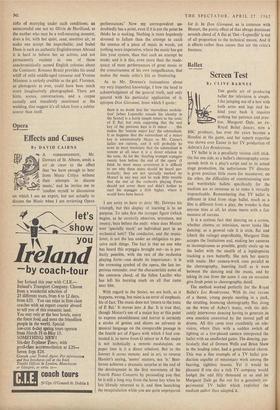Ballet
Screen Test
By CLIVE BARNES Tim gentle art of producing ballet for television is simple. Like jumping out of a box with both arms and legs tied be- hind your back it requires nothing but patience and prac- tice. Margaret Dale, an ex- Royal Ballet dancer, now a BBC producer, has over the years become a Houdini at the game, and her superb expertise was shown over Easter in her TV production of Ashton's Les Rendezvous.
TV ballet is in a peculiarly vicious cleft stick. On the one side, as a ballet's choreography corre- sponds both to a play's script and to its actual stage production, the unfortunate TV director is given precious little room for manoeuvre; on the other, the difficulties of commissioning new and worthwhile ballets specifically for the medium are so immense as to make it virtually impracticable. Remembering that TV ballet is different in kind from stage ballet, much as a film is different from a play, the wonder is that anyone tries at all, let alone meets with a fair measure of success.
It is a curious fact that dancing on a screen, whether cinema or television, never looks like dancing; as a general rule it is stale, flat and (check the ratings) unprofitable. Margaret Dale accepts the limitations and, making her cameras as inconspicuous as possible, gently steals up on the ballet with the stealth of a lepidopterist tracking a rare butterfly. She nets her quarry with music. Her camera-work runs parallel to the choreography, inserting itself as it were between the dancing and the music, and by taking its cue from the score it can on occasion give fresh point to choreographic detail.
The method worked perfectly for the Royal Ballet's Les Rendezvous. With its tiny excuse of a theme, young people meeting in a park, the strutting, bouncing choreography flies along on the wires of Auber's music, with the deli- cately interwoven dancing having to generate its own emotion unassisted by the merest puff of drama. All this came over excellently on tele- vision, where Dale with a sudden switch of lighting or a low-placed camera interpreted the ballet with an unaffected gusto. The dancing, par- ticularly that of Doreen Wells and Brian Shaw in the leading roles, had a good-natured charm. This was a fine example of a TV ballet pro- duction capable of missionary work among the heaving, sightless masses. Yet it would be pleasant if one day a rich TV company would budget the odd fifty thousand or so and let Margaret Dale go flat out for a genuinely ex- perimental TV ballet which exploited the medium rather than adapted it.














































 Previous page
Previous page